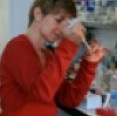Carole Seum

PROJECT
In Marcos Gonzalez’ lab, my goal is to visualize protein-protein interaction in living cells using the BIFC approach (Bimolecular Fluorescence Complementation). This technique consists of the use of a fluorophore split into two parts and fused to two different interactors. In vivo association of these two proteins leads to the reconstitution of the fluorescence otherwise absent from each isolated fragment. The best combinations of fused moieties was first tested in Schneider-2 cells (no self-association of naked fragments) and I then observed the interaction in a living organism such as Drosophila melanogaster. The interaction I want to evidence here is the nuclear association of pMad and Medea in the nucleus in response to Dpp signaling.
This technique will also allow me to trace in a living cell the dynamic of association of different proteins sharing a common interactor by a multicolor monitoring. This experiment can be realized using N-terminal fusions of different fluorophores and a common C-terminal part of Venus. I would like to visualize the interaction of Smox and Mad with Medea.
education/Academic background
For 15 years I have been studying chromatin organization and silencing using position-effect variegation in Drosophila melanogaster as a tool. I did my PhD in 2000 in P. Spierer’s laboratory, studying PEV using new genetic tools that were imported into the heterochromatic compartment. I then experienced successfully the homologous recombination technique described by Kent Golic, knocking down few genes such as Su(var)3-7, G9a and SETDB1, these two latest being histone methyl transferase specific for H3 on lysine 9, a mark known to be implicated in gene silencing. I also created few “knock-in” using the same technology. I am now currently using CRISPR/Cas9 in Drosophila as a tool for targeted genome editing of many genes commonly used in the lab.
